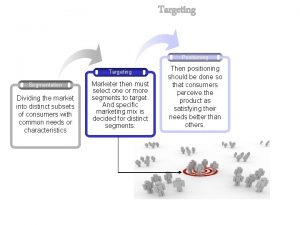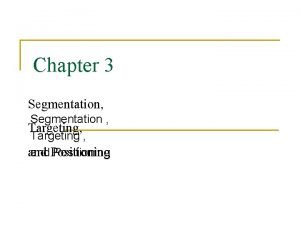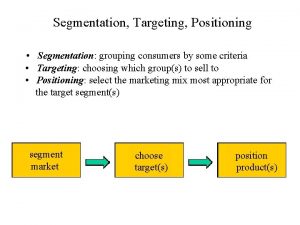Market Segmentation Targeting and Positioning Leonard Walletzk Segmentation






















- Slides: 22

Market Segmentation, Targeting, and Positioning © Leonard Walletzký

Segmentation Targeting Positioning Competitors Název prezentace v zápatí Marketing Mix Customer Company Context Collaborators STP 5 C Marketing framework 4 P 7 P 4 C 7 C 4 S 2

The STP Process Segmentation is the process of classifying customers into groups which share some common characteristic Targeting involves the process of evaluating each segments attractiveness and selecting one or more segments to enter Positioning is arranging for a product to occupy a clear, distinctive and desirable place relative to competing products in the mind of the consumer

Target Market A market is a set of all actual and potential buyers A target market is a group of people toward whom a firm markets its goods, services, or ideas with a strategy designed to satisfy their specific needs and preferences. Any marketing strategy must include a detailed (specific) description of this.

Advantages of Segmentation The process of breaking up a homogeneous market into heterogeneous segments forces the marketer to analyse and consider both the needs of the market and the company’s ability to competently serve those needs – thereby making the company better informed about its customers Competitor offerings and marketing positioning must also be analysed in this context so the company must consider what its competitive advantages and disadvantages are, helping it to clarify its own positioning strategy Limited resources are used to best advantage, targeted at those segments that offer the best potential

Levels of segmentation Mass Marketing Same product to all customers Segment Marketing Different products to one or more segments (some segmentation) Niche Marketing Different products to subgroups within segments (more segmentation) Micromarketing Products to suit the tastes of individuals and locations (complete segmentation) Local Marketing Tailoring brands/ promotions to local customer groups Individual Marketing Tailoring products/ programs to individual customers

Requirements for Effective Segmentation Measurable • Size, purchasing power, profiles of segments can be measured Accessible • Segments can be effectively reached and served. Substantial • Segments are large or profitable enough to serve Differential • Segments must respond differently to different marketing mix elements & programs. Actionable • Effective programs can be designed to attract and serve the segments.

Bases for customer segmaentation Geographic Demographic Psychographic Behavioral • Nation, States • Regions, Cities • Age, gender • Family size • Life cycle, Income • Social class • Lifestyle • Personality • Occasions • Benefits sought • User status • Loyality

Bases for Segmenting Business Markets Demographics • General criteria • Broad description of the company • Industry, Company size, Customer location Operating characteristics Purchasing approaches • Company Technology • Product Brand Use Status • Customer capabilities • Power structure • Buyer – Seller relationships • Purchasing policies Situational Factors • Important factor • Urgency or order fulfillment • Product Application • Size of order Personal Characteristics • Buyer – Seller Similarities and Synergies • Individual Behaviors • Risk Management

Segmenting International Markets Geographic Economics Political/Legal Cultural Intermarket

Evaluating Market Segments (developing selection criteria) Segment Size and Growth • Analyse sales, growth rates and expected profitability for various segments. Segment Structural Attractiveness • Consider effects of: Competitors, Availability of Substitute Products and, the Power of Buyers & Suppliers. Company Objectives and Resources • Company skills & resources relative to the segment(s). • Look for Competitive Advantages.

Market Targeting Market Coverage Strategies A. Undifferentiated Marketing Company Marketing Market B. Differentiated Marketing Company Marketing 1 Company Marketing 2 Company Marketing 3 Segment 1 Segment 2 Segment 3 C. Concentrated Marketing Company Marketing Segment 1 Segment 2 Segment 3

Market Targeting Company Resources Product Variability Product´s life cycle stage Market Variability Competitor´s marekting strategies

Positioning for Competitive Advantage Product’s Position • the way the product is defined by consumers on important attributes the place the product occupies in consumers’ minds relative to competing products. Marketers must • Plan positions to give their products the greatest advantage in selected target markets, • Design marketing mixes to create these planned positions.

Market Positioning Strategy Market Positioning Target Customers Competitive Frame Influences Substitutes Consumers Competitors Purchases Point of difference Value Proposition Economics Functional Emotional

Market Positioning Strategy

Marketing Positioning - Strategies Product Class Product Atributes Benefits Offered Usage Occasions User Class Against Competitor Away from Competitors

Steps to Choosing and Implementing a Positioning Strategy Identifying Possible Competitive Advantages: Competitive Differentiation. Selecting the Right Competitive Advantage: Unique Selling Proposition (USP). Communicating and Delivering the Chosen Position. Support the positioning strategy with a unique marketing

Developing Competitive Differentiation Product People Areas for Competitive Differentiation Image Service

Selecting the Right Competitive Advantages Important Profitable Affordable Distinctive What to promote? Preemptive Communicable Superior

Steps in Market Segmentation, Targeting and Positioning Market Segmentation Identify the bases for segmentation Develop Profiles of Resulting Segments Market Targeting Develop Selection Criteria Select Target Segments Market Positioning Develop Positioning for Each Target Segment Develop Marketing Mix for Each Target Segment

Summary Segmentation Types of segmentation Why to do Targeting How to evaluate segments How to choose the right segment Positioning How to develop strategy
 Segmentation levels
Segmentation levels Sony market segmentation, targeting and positioning
Sony market segmentation, targeting and positioning Chosen lesson 7 segment 1
Chosen lesson 7 segment 1 Case study segmentation targeting positioning
Case study segmentation targeting positioning Market segmentation, targeting and positioning
Market segmentation, targeting and positioning Positioning methods
Positioning methods Market segmentation targeting and positioning of coca cola
Market segmentation targeting and positioning of coca cola Nivea positioning strategy
Nivea positioning strategy Segmentation targeting differentiation and positioning
Segmentation targeting differentiation and positioning Nivea positioning
Nivea positioning Global marketing segmentation
Global marketing segmentation Market segmentation process
Market segmentation process Psychographic segmentation of nivea
Psychographic segmentation of nivea Segmentation targeting differentiation and positioning
Segmentation targeting differentiation and positioning Market segmentation variable
Market segmentation variable Global segmentation targeting and positioning
Global segmentation targeting and positioning International positioning strategies
International positioning strategies Kfc segmentation targeting positioning
Kfc segmentation targeting positioning 7 principles of marketing
7 principles of marketing Bssu
Bssu Segmenting targeting
Segmenting targeting Rural market segmentation and targeting
Rural market segmentation and targeting Consumer rooted segmentation
Consumer rooted segmentation










































